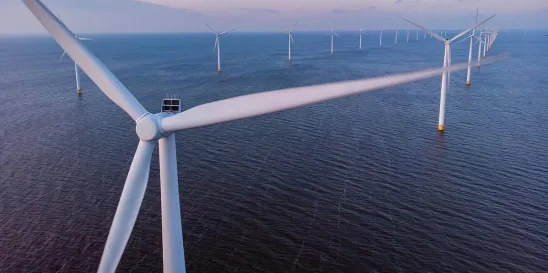On 17 November 2023, the US Department of the Treasury (Treasury Department) and Internal Revenue Service (IRS) issued proposed regulations (Proposed Regulations) updating rules for the investment tax credit (ITC) under Code1 Section 48 that have not been changed since 1987. The Proposed Regulations update the types of “energy properties” eligible for the ITC under Section 48, reflecting changes in the energy industry, technological advances, and the recent updates from the Inflation Reduction Act of 2022.
One of the key changes addressed by the Proposed Regulations was the definition of which components should be included as energy property, particularly in the context of offshore wind facilities. To avoid limiting future energy technologies, the Treasury Department and the IRS determined the best option is adopting a function-oriented approach to describe the types of components that are considered energy property.2 Accordingly, proposed §1.48-9(f) adopted the concepts of functional interdependence and property that is an integral part of an energy property as provided in the Internal Revenue Bulletin guidance issued previously by the Treasury Department and the IRS.3 However, energy property generally excludes equipment that is an addition or modification to an existing energy property, unless it is considered a retrofitted energy property under §1.48-14(a) (i.e., the “80/20 rule”).
FUNCTIONAL INTERDEPENDENCE AND INTEGRAL PART
The Proposed Regulations outline two ways a property could be identified as “energy property:” if (1) components of the property are functionally interdependent, or (2) a property is an integral part of an energy property.
A unit of energy property means all functionally interdependent components of property owned by the taxpayer that are operated together and that can operate apart from other energy properties within a larger energy project.4 Generally, components of property are functionally interdependent if the placing in service of each component is dependent upon the placing in service of each of the other components to generate or to store electricity, thermal energy, or hydrogen.5 Therefore, energy property includes components necessary to generate or to store electricity or thermal energy for transmission, distribution, or use up to, but not including, the transmission, distribution, or usage stage of electricity or thermal energy.
To be considered an integral part of an energy property, such property must be used directly in the intended function of the energy property and is essential to the completeness of the intended function.6
QUALIFIED OFFSHORE WIND PROPERTY APPLICATION: POWER CONDITIONING AND TRANSFER EQUIPMENT
The Proposed Regulations explain that power conditioning equipment and transfer equipment, such as subsea cables and voltage transformers, used to perform the intended function to condition electricity for use on the electrical grid are considered integral parts of the qualified offshore wind property and thus are energy property.7
Power conditioning equipment includes transformers, inverters, and converters.8 Parts related to the functioning or protection of power conditioning equipment are also treated as power conditioning equipment, such as switches, circuit breakers, arrestors, and hardware and software used to monitor, operate, and protect power conditioning equipment.9 Because these parts are related to the functioning or protection of power conditioning equipment, they are also treated as power conditioning equipment, and thus are energy property as well.
Transfer equipment includes wires, cables, and combiner boxes that aggregate energy or alter voltages to transfer to a transmission or distribution line.10 Similar to power conditioning equipment, parts related to the functioning or protection of transfer equipment are also treated as transfer equipment, which may include current transformers used for metering, electrical interrupters (such as circuit breakers, fuses, and other switches), and hardware and software used to monitor, operate, and protect transfer equipment.11 Because these related parts are treated as transfer equipment, they are also considered energy properties. However, transfer equipment does not include transmission or distribution lines and towers.12 In other words, transmission and distribution equipment are not functionally interdependent components of an energy property nor are they an integral part of an energy property. The Treasury Department drew the line of separation between the transmission and related equipment moving power from the offshore wind farm and the larger transmission and distribution system on the other side of the transformer and switch gear of an onshore receiving substation.
To illustrate and clarify applicability, the Treasury Department provided the following example:13
“Taxpayer A builds an offshore wind facility (“Offshore Wind Facility”) with 150 turbines and elects for the Section 48 ITC instead of the Section 45 credit.14 The facility's turbines generate alternating current electricity, which is transmitted via inter-array cables to an offshore substation. Here, the electricity undergoes voltage transformation and conversion to direct current for transfer to an onshore substation via subsea export cables. At this onshore site, the electricity is converted back to alternating current. It then passes through a transformer and associated switchgear where it will be converted to electrical grid voltage and where the Offshore Wind Facility can be electrically isolated from the grid.
All components of the Offshore Wind Facility, up to and including the transformer and switchgear housed in the onshore substation, are either functionally interdependent components of an energy property or integral parts of an energy property. Therefore, the Offshore Wind Facility is an energy property, and the cost of the components up to and including the transformer and switchgear housed in the onshore substation are included in the basis of the Offshore Wind Facility for purposes of computing the Section 48 ITC.”
Due to the Proposed Regulation’s specific application of the “integral part” concept to qualified offshore wind properties, it is crucial for offshore wind industries to have a clear understanding of the treatment of subsea cables and voltage transfers. The clear treatment set out in the draft regulations allows for the accurate calculation of the portion of the component costs that should be included in the basis of the energy property for purposes of computing the Section 48 ITC.
THE ITC APPLICATION TO ENERGY PROPERTY BEYOND THE WIND FARM IS DEPENDENT ON OWNERSHIP OF THE OFFSHORE GENERATION
A taxpayer must directly own at least a fraction interest in the entire unit of energy property to be eligible for a Section 48 ITC.15 The Treasury Department stated that: if one taxpayer owns the power conditioning and transfer equipment while another unrelated taxpayer owns the turbines, only the taxpayer who owns the turbines is eligible to claim the Section 48 ITC, and provided the following example.16 For instance, Taxpayer A now only owns power conditioning and transfer equipment while the 150 turbines are owned by an unrelated Taxpayer B. Because Taxpayer A only owns the power conditioning and transfer equipment, Taxpayer A would not be eligible for the Section 48 ITC. Only Taxpayer B, as the owner of the 150 turbines, can claim the Section 48 ITC. In short, only the taxpayer directly owning the energy property unit can claim the Section 48 ITC. Partnerships or joint ventures between owners of turbines and eligible power conditioning equipment may allow for tax planning in order to maximize the property that is eligible for tax credits for Offshore Wind projects even under the current guidance.
IMPLICATIONS FOR OFFSHORE PLANNED TRANSMISSION SYSTEMS
While providing clarity that transmission and voltage conversion equipment bundled with an offshore wind farm qualify as energy property, independent transmission is excluded from the ITC. Certain states, starting with New Jersey, have sought to develop transmission systems that can integrate more than one wind farm and in the process materially reduce the amount of transmission needed to interconnect a larger amount of offshore energy.17 New England has signaled that it is exploring a shared transmission build out for its six-state region,18 while the Department of Energy Atlantic Action Plan19 and Pacific Northwest National Labs September 2023 study of Northern California and Southern Oregon20 show material cost and reliability benefits from offshore multi-terminal high-voltage direct current (HVDC) transmission systems. Depending on the scale of these shared HVDC transmission systems, savings from reduced equipment or other benefits may equal or exceed the ITC. Whether there are any arguments that may further expand energy property to account for generation-like characteristics of HVDC systems remains to be seen.21
NEXT STEPS
Comments on the proposed regulations are due 60 days after publication of the draft regulations in the Federal Register, or 22 January 2024. The Treasury Department will also conduct a hearing on 20 February 2024.
1 Unless otherwise indicated, all statutory references are to the Internal Revenue Code, Title 26 U.S.C., in effect at all relevant times.
2 Prop. Treas. Reg. § 1.48-9(f)(2).
3 See, e.g., I.R.S. Notice 2018-59, 2018-28 I.R.B. 196.
4 See Prop. Reg. Teas. § 1.48-9(f)(2)(i).
5 Id. § 1.48-9(f)(2)(ii).
6 Prop. Reg. Teas. § 1.48-9(f)(3)(i).
7 Id. § 1.48-9(f)(3)(ii).
8 Id.
9 Id.
10 Id.
11 Id.
12 Id. § 1.48-9(f)(1).
13 See, e.g., Prop. Reg. Teas. § 1.48-9(f)(5)(iii).
14 Section 45 is the Production Tax Credit (PTC). Owners of energy property must opt to utilize either the ITC or PTC.
15 See Prop. Reg. Teas. § 1.48-14(e)(2).
16 See, e.g., Prop. Reg. Teas. § 1.48-14(e)(4).
17 The Benefit and Urgency of Planned Offshore Transmission: Reducing the Costs and Barriers to Achieving U.S. Clean Energy Goals, J. Pfeifenberger, C. Plet, et al. January 24, 2023.
18 The New England States Transmission Initiative
19 Offshore Wind Transmission Development in the U.S. Atlantic Region, Interim Draft, U.S. Dept. of Energy, U.S. Bureau of Ocean Energy Management, September 2023.
20 An Offshore Wind Energy Development Strategy to Maximize Electrical System Benefits in Southern Oregon and Northern California, T. Douville, et al., September 2023.
21 These traditional generator functions include the ability of HVDC systems to “black start” a grid after a large blackout, as well as system frequency and voltage support.




 />i
/>i
